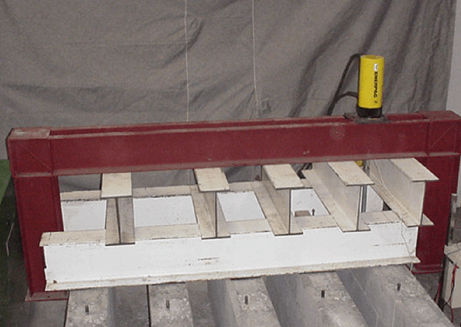Terence A. Weigel[1], J. P. Mohsen[2], Andrew Schad[3] and Karl Erdmann[4]
- Associate Professor, Department of Civil and Environmental Engineering, University of Louisville, Louisville, Kentucky USA, 40292 – taw@louisville.edu
- Associate Professor, Department of Civil and Environmental Engineering, University of Louisville, Louisville, Kentucky USA, 40292 – jpmohs01@louisville.edu
- Graduate Student, Department of Civil and Environmental Engineering, University of Louisville, Louisville, Kentucky USA, 40292 – aschad3983@aol.com
- Graduate Student, Department of Civil and Environmental Engineering, University of Louisville, Louisville, Kentucky USA, 40292 – kerdmann@gateway.net
ABSTRACT
An anchor bolt testing program currently is underway at the University of Louisville. Its purpose is to quantify the effects of edge distance on the strength of anchor bolts embedded in concrete masonry. Both headed and L-shaped anchor bolts embedded in the tops of concrete masonry specimens will be tested in either tension, in-plane or out-of-plane shear. This paper reports the results of the first phase of headed bolts tested in tension.
Three-course-high specimens were constructed using Type S PCL mortar and concrete masonry knock-out web bond beam units. All specimens were fully grouted. Headed bolts were embedded in the “tops” of these specimens, in order to simulate construction in which bolts are embedded in the tops of masonry walls.
Testing was accomplished by loading each anchor bolt using a hydraulic ram. Bolt displacements were measured using an LVDT, and plots of displacement versus load were obtained. A total of five edge distances were used for this phase of the tensile loading program, and will also be used for the in-plane and out-of-plane shear loading programs. At each of these distances, a total of five replicates were tested.
This paper reports the results of the tensile testing program, including average ultimate load achieved by each type of bolt for each edge distance; typical plots of bolt displacement versus applied load; total bolt displacement at both ultimate and final load; a graph of ultimate load versus edge distance; failure mode; and finally, comparison of maximum load achieved with allowable bolt loads calculated using MSJC code provisions.
Key words Anchor bolts, masonry, concrete masonry, tension, edge distance, headed bolts
anchor03



